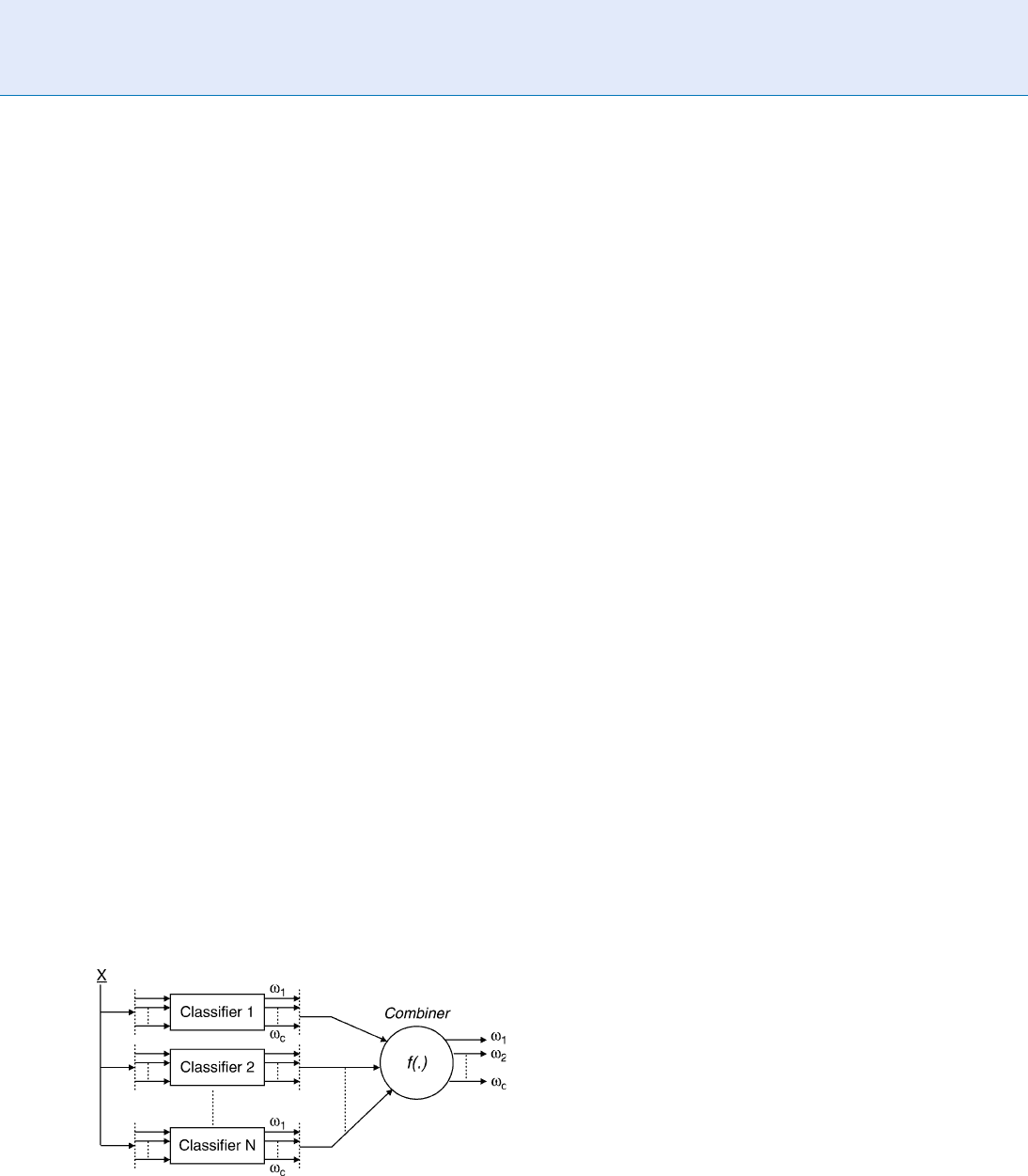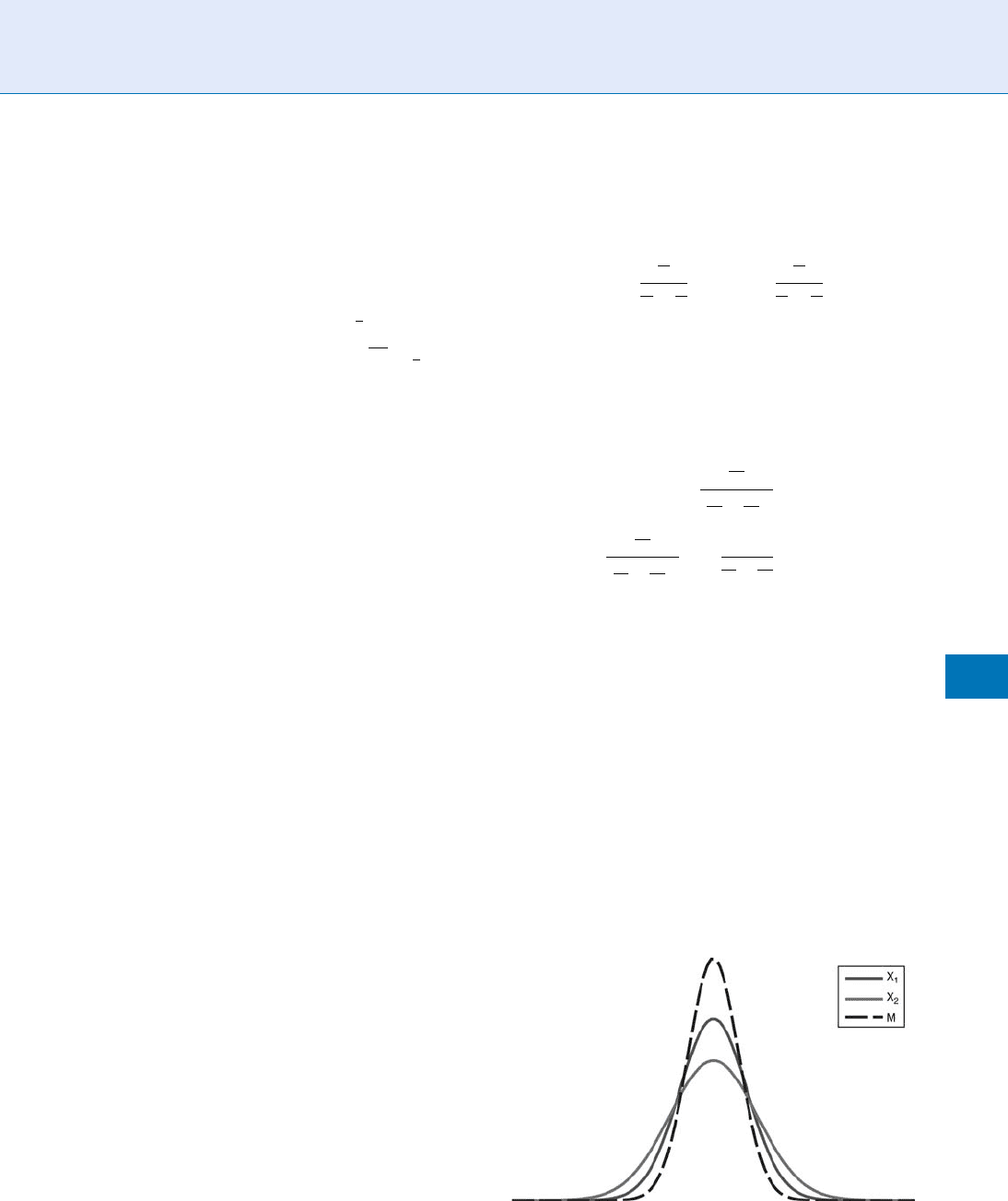Li S.Z., Jain A.K. (eds.) Encyclopedia of Biometrics
Подождите немного. Документ загружается.


▶ Multi-Samp le Systems
▶ Multi-Sensor System s
▶ Multi-Unit Systems
▶ Multiple Classifier Sys tems
▶ Multiple Experts
▶ Score-Level Fusion
References
1. Korves, H., Nadel, L., Ulery, B., Masi, D.: Multibiometric fusion:
From research to operations. Mitretek Sigma, Summer 2005
(2005)
2. ISO/IEC JTC 1/SC 37 Standing Document 2 – Harmonized
Biometric Vocabulary, ISO/IEC JTC 1/SC 37 N2263 (2007)
3. Jain, A.K., Nandakumar, K., Ross, A.: Score normalization in
multimodal biometric systems. Pattern Recognit. 38(12),
2270–2285 (2005)
4. Wang, Y., Tan, T., Jain, A.K.: Combining face and iris biometrics
for identity verification. In: Proceedings of the Fourth Interna-
tional Conference on Audio- and Video-Based Biometric Person
Authentication, Guildford, UK, pp. 805–813 (2003)
5. Kittler, J., Hatef, M., Duin, R.P., Matas, J.G.: On combining
classifiers. IEEE Trans Pattern Anal. Mach. Intell. 20(3),
226–239 (1998)
6. Neyman, J., Pearson, E.S.: On the problem of the most efficient
tests of statistical hypotheses. Philos. Trans. R. Soc. Lond A. 231,
289–337 (1933)
7. Ross, A., Govindarajan, R.: Feature level fusion using hand and
face biometrics. In: Proceedings of the SPIE Conference on
Biometric Technology for Human Identification, Orlando,
USA, pp. 196–204 (2005)
8. Chang, K., Bowyer, K.W., Sarkar, S., Victor, B.: Comparison and
combination of ear and face images in appearance-based
biometrics. IEEE Trans. Pattern Anal. Mach. Intell. 25(9),
1160–1165 (2003)
9. Kumar, A., Wong, D.C.M., Shen, H.C., Jain, A.K.: Personal
verification using palmprint and hand geometry biometric. In:
Proceedings of the Fourth International Conference on Audio-
and Video-Based Biometric Person Authentication, Guildford,
UK, pp. 668–678 (2003)
10. ISO/IEC TR 24722:2007, Information technology – Biometrics –
Multimodal and other multibiometric fusion (2007)
11. ANSI INCITS 439, Information Technology – Fusion Informa-
tion Format for Data Interchange (2008)
12. ISO/IEC 19784-1:2006, Information technology – Biometric
Application Programming Interface – Part 1: BioAPI Specifica-
tion (2006)
13. ANSI INCITS 358–2002, Information technology – BioAPI
Specification (2002)
14. ANSI INCITS 358-2002/AM1-2007, Information technology –
BioAPI Specification – Amendment 1: Support for Biometric
Fusion (2007)
15. ISO/IEC 24713–3, Information technology – Biometric profiles
for interoperability and data interchange – Part 3: Biometric
based verification and identification of Seafarers (2008)
Multifactor
Multifactor authentication/identification solutions
consist of a combination (integrated or loosely linked)
of different categories of authentication and identifica-
tion technologies. A multifactor solution could thus be
composed of a fingerprint recognition system tied to a
proximity card reader and a PIN-based keypad system.
▶ Fraud Reduction, Overview
Multimodal
▶ Multibiometrics
Multimodal Fusion
▶ Multiple Experts
Multimodal Jump Kits
A compact, durable, and mobile kit that encases mul-
tiple biometric testing devices. An example kit is a
briefcase that contains digital fingerprints, voice and
iris prints, and photographs.
▶ Iris Acquisition Device
Multiple Classifier Fusion
▶ Fusion, Decision-Level
980
M
Multifactor

Multiple Classifier Systems
FAB IO ROLI
Department of Electrical and Electronic Engineering ,
University of Cagliari, Piazza d’Armi, Cagliari, Italy
Synonyms
Classifier combination; Ensemble learning; Multiple
classifiers; Multiple expert systems
Definition
The rationale behind the growing interest in multiple
classifier systems is the acknowledgment that the clas-
sical approach to design a pattern recognition system
that focuses on finding the best individual classifier has
some serious drawbacks. The most common type of
multiple classifier system (MCS) includes an ensemble
of classifiers and a function for parallel combination of
classifier outputs. However, a great number of methods
for creating and combining multiple classifiers have
been proposed in the last 15 years. Alth ough reported
results showed the good performances achievable by
combining multiple classifiers, so far a designer of
pattern classification systems should regard the MCS
approach as an additional tool to be used when build-
ing a single classifier with the required performance is
very difficult, or does not allow exploiting the comple-
mentary discriminatory informati on that other classi-
fiers may encapsulate.
Motivations of Multiple Classifiers
The traditional approach to classifier design is based
on the ‘‘evaluation and selection’’ method. Perfor-
mances of a set of different classification algorithms
are assessed against a data set, name validation set, and
the best classifier is selected. This approach works well
when a large and representative data set is available, so
that the estimated performances allow selecting the
best classifier for future data collected during the oper-
ation of the classifier machine. However, in many real
cases where only small training sets are available, esti-
mated performances can substantially differ from the
ones that classifiers will exhibit during their operation.
This is the well-known phenomenon of the generaliza-
tion error, which can makes impossible the selection of
the best individual classifier, or cause the selection of a
classifier with a poor performance. In the worst case,
the worst classifier in the considered ensemble could
exhibit the best apparent accuracy when assessed
against a small vali dation set.
A first motivation for the use of multiple classifiers
comes from the intuition that instead of selecting a
single classifier, a safer option would be to use them all
and ‘‘average’’ their outputs [1, 2]. This combined
classifier might not be better than the individual best
classifier, but the combination should reduce the risk
of selecting a classifier with poor performance. Experi-
mental evidences and theoretical results support this
motivation. It has been proved that averaging the out-
puts of multiple classifiers do eliminates the risk of
selecting the worst classifier, and can provide a perfor-
mance better than the one of the best classifier under
particular conditions [3].
Dietterich suggested further reasons for the use of
a multiple classifier system (MCS) [2]. Some classifiers,
such as neural networks, are trained with algorithms
that may lead to different solutions, that is, different
classification accuracies, depending on the initial
learning conditions. Combining multiple classifiers
obtained with different initi al learning conditions
(e.g., different initial weights for a neural net), reduces
the risk of selecting a classifier associated to a poor
solution of the learning algorithm (a so called ‘‘local
optimum’’). The use of MCS can simplify the problem
of choosing adequate values for some relevant para-
meters of the classification algorithm (e.g., the number
of hidden neurons in a neural net). Multiple versions
of the same classifier with different values of the para-
meters can be combined. In some practical cases with
small training sets, training and combining an ens-
emble of simple classifie rs (e.g., linear classifiers) to
achieve a certain high accuracy can be easier than
training directly a complex classifier [4]. Finally, for
some applications, such as multi-modal biometrics,
the use of multiple classifiers is naturally motivated
by application requirements.
It is worth noting that the above motivations neither
guarantee that the combination of multiple classifiers
always performs better than the best individual classifier
in the ensemble, nor an improvement on the ensemble’s
average performance for the general case. Such guaran-
tees can be given only under particular conditions that
Multiple Classifier Systems
M
981
M

classifiers and the combination function have to satisfy
[3]. However, reported experime ntal results and theo-
retical works developed for par ticular combination
functions show the good performances achiev able
by combining multiple classifiers. So far a designer of
pattern classification systems should regard the MCS
approach as an additional tool to be used when build-
ing a single classifier with the required performance is
very difficult, or does not allow exploiting the comple-
mentary discriminatory informati on that other classi-
fiers may encapsulate.
Design of Multiple Classifier Systems
The most common type of MCS, widely used and
investigated, includes an ensemble of classifiers,
named
▶ ‘‘base’’ classifiers, and a function for parallel
combination of classifier outputs (Fig. 1). The base
classifiers are often algorithms of the same type (e.g.,
decision trees or neural networks), and statistical clas-
sifiers are the most common choice. The use of hybrid
ensembles containing different types of algorithms
has been investigated much less, as well as ensembles
of structural classifiers have not attracted much atten-
tion, though they could be important for some real
applications.
The design of a MCS involves two main phases: the
design of the classifier ensemble and the design of the
combination function [4]. Although this formulation
of the design problem leads one to think that effective
design should address both the phases, most of the
design methods described in the literature focused
on only one. Two main design approaches have been
proposed, that Ho called ‘‘coverage optimization’’ and
‘‘decision optimization’’ methods [5]. Coverage opti-
mization refers to methods that assume a fixed, usually
simple, decision combination function and aim to
generate a set of mutually complementary classifiers
that can be combined to achieve optimal accuracy.
Several techniques have been proposed for creating a
set of mutually complementary classifiers. The main
approaches are outlined in the following. However,
decision optimization methods assume a given set
of carefully designed classifiers and aim to select and
optimize the combination function. These metho ds fit
well with those applications where a set of classifiers
developed separately is already available (e.g., a face
and a fingerprint classifier in biometric applications)
and one is interested in combining them optimally.
A large set of combination functions of increasing
complexity is available to the designer to perform the
selection and optimization, ranging from simple vot-
ing rules through ‘‘trainable’’ combination functions.
The three main types of combination functions are
briefly explained below. There are few methods for
building a MCS that cannot be classified as either a
decision optimization or a coverage optimization
method. For example, MCS based on the mixture of
experts model trains the classifiers and the combi-
nation function simultaneou sly, so implementing a
sort of joint optimization [6]. In some works dealing
with real-life applications, hybrid design methods that
first generate a classifier ensemble and then select and
optimize the combination function have been also
proposed.
It is easy to see that the classifiers in a MCS should
be as accurate as possible and should not make coinci-
dent errors. Although this sounds an intuitive and
simple concept, it revealed a complex issue that was
addressed in the literature under the name of classifier
‘‘diversity’’ [1, 7]. The type of diversity required for
maximizing MCS performance obviously depends on
the combination function used. As an example, coin-
cident errors can be tolerated if the majority-voting
rule is used, but the majority of classifier decisions
should be always correct. Many diversity measures
have been proposed, and some of them have been
also used to design effective MCSs [4]. The main
approaches for creating multiple classifiers, which are
outlined in the following, aim to induce classifier di-
versity. However, so far it appeared to be difficult to
Multiple Classifier Systems. Figure 1 Standard
architecture of a multiple classifier system for a
classification task with c classes. The multiple classifier
system is made up by an ensemble of N classifiers and a
function for parallel combination of classifier outputs.
982
M
Multiple Classifier Systems

define diversity measures that are related well to the
MCS performance, so that such performance can be
predicted by measuring the diversity of the classifiers.
Although the parallel architecture was the most
used and investigated (Fig. 1), other types of architec-
tures are also possible. For example, serial architectures
where classifiers are applied in succession, with each
classifier working on inputs, which previous classifiers
were not able to recognize w ith a sufficient confidence.
Such architectures could be very important for real
applications that demand for a trade-off between ac-
curacy and computational complexity. However, non-
parallel architectures have been relatively neglected.
Although some design methods proved to be very
effective and some works investigated the comparative
advantages of different methods [4, 5], clear guidelines
are not yet available for choosing the best design meth-
od for the classification task at hand. The designer of
MCS has a toolbox containing quite a lot of instru-
ments for generating and combining classifiers. She/he
may design a myriad of different MCSs by coupling
different techniques for creating classifier ensembles
with different combination functions. However, for
the general case, the best MCS can only be determined
by performance evaluation. Optimal design is possible
only under particular assumptions on the classifiers
and the combination func tion [3].
Creating Classifier Ensembles
Several techniques hav e been proposed for creating a set
of complementary classifiers. All these techniques try to
induce classifier diversity, namely , to create classifiers
that make errors on differ ent patterns, so that they can
be combined effectively. In the following, the main
approaches to classifier ensemble generation are outlined.
Using Different Base Classifiers
A simple way for generating multiple classifiers is using
base classifiers of different types. For example, classi-
fiers based on different models (e.g., neural networks
and decisio n trees) or using different input informa-
tion. This simple technique may work well for applica-
tions where complementary information sources are
available (e.g., multi-sensor applications) or distinct
representations of patterns are possible (e.g., minu-
tiae-based and texture-based representations in finger-
print classification).
Injecting Randomness
Random variation of some parameters of the learning
or classification algorithm can be used to create multi-
ple classifiers. The classifier ensemble is created using
multiple versions of a certain base classifier obtained
by random variation of some parameters. For example,
training a neural network several times with different
random values of the initial weights allows generating a
network ensemble.
Manipulating Training Data
These techniques generate multiple classifiers by train-
ing a base classifier with different data sets. To this end,
the most straightforward method is the use of disjoint
training sets obtained by splitting the original training
set (this technique is called sampling without replace-
ment). A very popular technique based on training
data manipulation is Bagging (Bootstrap AGGregat-
ING) [8]. Bagging creates an ensemble made of N
classifiers trained on N bootstrap replicates of the
original training set. A bootstrap replicate consists of
a set of m patterns drawn randomly with replacement
from the original training set of m patterns. The clas-
sifiers are usually combined by majority voting rule, or
by averaging their outputs. Another po pular techn ique
based on training data manipulation is Boosting [9].
This method incrementally builds a classifier ensemble.
The classifier that joins the ensemble at step k is forced
to learn patterns that previous classifiers have misclas-
sified. In other words, while Bagging samples each
training pattern with equal probability, Boosting fo-
cuses on those training patterns that are most often
misclassified. Essentially, a set of weights is maintained
over the training set and adaptive resampling is per-
formed, such that the weights are increased for those
patterns that are misclassified. It is worth noting that
Boosting is a complete design method, where the com-
bination function is also specified, and it is not only a
technique for generating a classifier ensemble.
Manipulating Input Features
Manual or aut omatic feature selection can be used for
generating multiple classifiers using different feature
sets as inputs. Ho proposed a successful technique of
this type, call ed Random Subspace Method [10]. Fea-
ture space is randomly sampled, such that complemen-
tar y classifiers are obtained by training them with
different feature sets.
Multiple Classifier Systems
M
983
M

Manipulating Output Labels
A multiclass problem can be subdivided into a set of
subproblems (e.g., two-class problems), and a classifier
can be associated to each subproblem, thereby gener-
ating an ensemble. The standard problem subdivision
is the so-called ‘‘one-per-class’’ decomposition, where
each classifier in the ensemble is associated to one of
the classes and it is aimed to discriminate such class
from the others. Dietterich and Bakiri proposed a
general method, called ECOC (error correcting output
codes) method, for generating multiple classifiers by
decomposing a multiclass task into subtasks [11].
Combining Multiple Classifiers
There are two main strategies in combining classifiers:
fusion and selection [1]. The most of the combination
functions follow one of these basic strategies, with the
majority of combination methods using the fusion strat-
egy. There are few combiners that use hybrid strategies,
where fusion and selection are merged. In classifier fu-
sion, each classifier contributes to the final decision for
each input pattern. In classifier selection, each classifier
is supposed to have a specific domain of competence
(e.g., a region in the feature space) and is responsible for
the classification of patterns in this domain. There are
combination functions lying between these two main
strategies. For example, the mixture of experts model
uses a combination strategy that, for each input pattern,
selects and fuses a subset of available classifiers [6]. Some
combination functions, such as the majority-voting
rule, are called ‘‘fixed’’ combiners because they do not
need training (i.e., they do not nee d estimation of
parameters from a training set). Other combination
functions need additional training and they are called
‘‘trainable’’ combiners. For example, the weighted
majority-voting rule needs to estimate weights that
are used to give different importance to the classifiers
in the vote. Trainable combiners can obviously outper-
form the fixed ones, supposed that a large enough and
independent validation set for training them in an
effective way is available [4]. It should be noted that
each classifier in the ensemble is often biased on the
training data, so that the combiner should not be
trained on such data. An additional data set that is
independent from the training set used for the individ-
ual classifiers should be used. In general, the complex-
ity of the combiner should be adapted to the size of the
data set available. Complex trainable combiners, that
need to estimate a lot of parameters, should be used
only when large data sets are available [1, 12].
Fusion of Multiple Classifiers
The combination functions following the fusion strat-
egy can be classified on the basis of the type of outputs
of classifiers forming the ensemble. Xu et al. distin-
guish between three types of classifier outputs [13]: (1)
Abstract-level output: Each classifier outputs a unique
class label for each input pattern; (2) Rank-level out-
put: Each classifier outputs a list of ranked class labels
for each input pattern. The class labels are ranked in
order of plausibility of being the correct class label;
(3) Measurement-level output: Each classifier outputs
a vector of continuous-valued measures that represent
estimates of class posterior probabilities or class-
related confidence values that represent the support
for the possible classific ation hypotheses. On the
basis of this classification, the following three classes
of fusion rules can be defined.
Abstract-Level Fusion Rules
Among the fusion rules that use only class labels
to combine classifier outputs, the most often used
rule is the majority vote that assigns the input pattern
to the majority class, that is, the pattern is assigned
to the most frequent class in the classifier outputs.
A natural variant of the majority vote, namely, the
plurality vote, is also used. The trainable version of
the majority vote rule is the weighted majority vote
that uses weights that are usually related to the classifi-
er performances. Among the trainable fusion rules of
this type, a popular rule is the Behavior Knowledge
Space (BKS) method [1]. In the BKS method, every
possible combination of abstract-level classifiers outputs
is regarded as a cell in a look-up table. The BKS table is
designed by a training set. Each cell contains the samples
of the training set characterized by a particular value of
class labels. Training samples in each cell are subdivided
per class, and the most representative class label (the
‘‘majority’’ class) is selected for each cell. For each un-
known test pattern, the classification is performed
according to the class label of the BKS cell indexed by
the classifier outputs. The BKS method requires very
large and representative data sets to work well.
Rank-Level Fusion Rules
The most commonly used rule of this type is the Borda
Count method. The Borda count method combines
984
M
Multiple Classifier Systems

the lists of ranked class labels provided by classifiers ,
and it classifies an input pattern by its overall class
rank, that is computed summing the rank values
that classifiers assigned to the pattern for each class.
The class with the maximum overall rank is the winner.
Rank-level fusion rules are suitable for problems
with many classes, where the correct class may appear
often near the top of the list, although not always at
the top.
Measurement-Level Fusion Rules
Examples of fixed rules that combine continuous clas-
sifier outputs are: the simple mean (average), the max-
imum, the minimum, the median, and the product of
classifier outputs [1]. Linear combiners (i.e., the aver-
age and its trainable version, the weighted average) are
used in popular ensemble learning algorithms such as
Bagging [8], the Random Subspace Method [10], and
AdaBoost [1, 9], and represent the baseline and first
choice combiner in many applications. Continuous
classifier outputs can be also regarded as a new feature
space (an intermediate feature space [1]). Another
classifier that takes classifier outputs as input and out-
puts a class label can do the combination. However,
this approach usually demands very large data sets that
allow training effectively this additional classifier. The
Decision Templates method is an interesting example
of a trainable rule for combining continuous classifier
outputs [1]. The idea behind decision templates com-
biner is to store the most typical classifier outputs
(called decision template) for each class, and then
compare it with the classifier outputs obtained for
the input pattern (called decision profile of the input
pattern) using some similarity measure.
Selection of Multiple Classifiers
In classifier selection, the role of the combiner is selecting
the classifier (or the subset of classifiers) to be used for
classifying the input pattern, under the assumption that
different classifiers (or subsets of classifiers) hav e different
domains of competence. Dynamic classifier selection
rules have been proposed that estimate the accuracy of
each classifier in a local region surrounding the pattern to
be classified, and select the classifier that exhibits the
maximum accuracy [14, 15]. As dynamic selection
may be too computationally demanding and require
large data sets for estimating the local classifier accura-
cy, some static selection rules have also been proposed
where the regions of competence of each classifier are
estimated before the operational phase of the MCS [1].
Classifier selection has not attracted as much atten-
tion as classifier fusion, probably due to the practical
difficulty of identifying the domains of competence
of classifiers that make possible an effective selection.
Related Entries
▶ Ensemble Learning
▶ Fusion, Decision-Level
▶ Fusion, Rank-Level
▶ Fusion, Score-Level
▶ Multi-Algorithm Systems
▶ Multiple Experts
References
1. Kuncheva, L.I.: Combining Pattern Classifiers: Methods and
Algorithms, Wiley, NY (2004)
2. Dietterich, T.G.: Ensemble methods in machine learning, Multi-
ple Classifier Systems, Springer-Verlag, LNCS, 1857, 1–15 (2000)
3. Fumera, G., Roli, F.: A Theoretical and experimental analysis of
linear combiners for multiple classifier systems. IEEE Trans.
Pattern Anal. Mach. Intell. 27(6), 942–956 (2005)
4. Roli F., Giacinto, G.: Design of multiple classifier systems. In:
Bunke, H., Kandel, A. (eds.) Hybrid Methods in Pattern Recog-
nition, World Scientific Publishing (2002)
5. Ho, T.K.: Complexity of classification problems and compara-
tive advantages of combined classifiers, Springer-Verlag, LNCS,
1857, 97–106 (2000)
6. Jacobs, R., Jordan, M., Nowlan, S., Hinton, G.: Adaptive mix-
tures of local experts. Neural Comput. 3, 79–87 (1991)
7. Kuncheva, L.I., Whitaker, C.J.: Measures of diversity in classifier
ensembles. Mach. Learn. 51, 181–207 (2003)
8. Breiman, L.: Bagging predictors. Mach. Learn. 24, 123–140
(1996)
9. Freund, Y., Schapire, R.E.: A decision-theoretic generalization of
on-line learning and an application to boosting. J. Comput. Syst.
Sci. 55(1), 119–139 (1997)
10. Ho, T.K.: The random subspace method for constructing deci-
sion forests. IEEE Trans. Pattern Anal. Mach. Intell. 20, 832–844
(1998)
11. Dietterich, T.G., Bakiri, G.: Solving multiclass learning problems
via error-correcting output codes. J. Artif. Intell. Res. 2, 263–286
(1995)
12. Roli, F., Raudys, S., Marcialis, G.L.: An experimental comparison
of fixed and trained fusion rules for crisp classifiers outputs. In:
Proceedings of the third International Workshop on Multiple
Classifier Systems (MCS 2002), Cagliari, Italy, June 2002, LNCS
2364, 232–241 (2002)
Multiple Classifier Systems
M
985
M

13. Xu, L., Krzyzak, A., Suen, C.Y.: Methods for combining multiple
classifiers and their applications to handwriting recognition.
IEEE Trans. Syst. Man Cybern. 22(3), 418–435 May/June (1992)
14. Woods, K., Kegelmeyer, W.P., Bowyer, K.: Combination of mul-
tiple classifiers using local accuracy estimates. IEEE Trans. Pat-
tern Anal. Mach. Intell. 19(4), 405–410 (1997)
15. Giacinto, G., Roli, F.: Dynamic Classifier Selection Based on
Multiple Classifier Behavior. Pattern Recognit. 34(9), 179–181
(2001)
Multiple Classifiers
▶ Multiple Classifier Systems
Multiple Expert Systems
▶ Multiple Classifier Systems
Multiple Experts
JOSEF BIGU N
Halmstad University, IDE, Halmstad, Sweden
Synonyms
Decision fusion; Feature fusion; Fusion; Multimodal
fusion; Score fusion
Definition
A Biometric expert, or an expert in bio metric recogni-
tion context, refers to a method that expresses an
opinion on the likelihood of an identity by analyzing
a signal that it is specialized on, e.g. a fingerprint expert
using minutiae, a lip-motion expert using statistics of
optical-flow. Accordingly, there can be several experts
associated with the same sensor data, each analyzing
the data in a different way. Alternatively, they can be
specialized on different sensor data. Multiple experts
can address the issue of how expert opinions should
be represented and reconciled to a single opinion on
the authenticity of a
▶ client identity.
Introduction
In biometric signal analysis, the fusion of multiple
experts can in practice be achieved as
▶ feature fusion
or score fusion. In addition to these, one can also
discern data fusion, e.g. stereo images of a face, and
decision fusion, e.g. the decisions of several experts
wherein each expresses either of the crisp opinions
‘‘client’’ or ‘‘
▶ impostor,’’ in the taxonomy of fusion
[1]. However, one can see data fusion and decision
fusion as adding novel experts and as a special case of
score fusion, respectively. On the other hand, feature
fusion is often achieved as concatenation of feature
vectors, which is in turn modeled by an expert suitable
for the processing demands of the set of the novel
vectors. For this reason we only discuss score fusion
in this article. The initial frameworks for fusion have
been simplistic in that no knowledge on the skills of
the experts is used by the
▶ super visor. Later efforts
to reconcile different expert opinions in a multiple
experts biometric system have been described from
a probabilistic opinion modeling [2] and a pattern
discrimination [3], view points, respectively. From
both perspectives, it can be concluded that the weight-
ed average is a good way of reconciling different
authenticity scores of individual exp erts to a single
opinion, under reasonable conditions. As the weights
reflect the skills of the exper ts, some sort of training is
needed to esti mate them. Belonging to probabilistic
modeling school, respective discriminant analysis
school, Bayesian modeling [4, 5], and support vector
machines [6–8 ] have been utilized to fuse expert opi-
nions. An important issue for a fusion method is,
however, whether or not it has mechanisms to discern
the general skill of an expert from the quality of the
current data. We summarize the basic principles to
exemplify typical fusion approaches as follows.
Simple Fusion
This type of fusion applies a rule to input opinions
delivered by the experts. The rule is not obtained by
986
M
Multiple Classifiers

training on expert opinions, but are decided by the
designer of the supervisor. Assuming that the supervi-
sor receives all expert inputs in parallel, common sim-
ple fusions include,
where M
j
is the score output by the supervisor
at the instant of operation j, when m expert opinions,
expressed as real numbers x
i,j
,i :1...m, are available to
it. In addition to a parallel application of a single
simple fusion to all expert opinions, one can apply
several simple fusion rules serially (one after the
other) if some expert opinions are delayed before
they are processed by the supervisor(s).
Probabilistic Fusion
Experts can express opinions in various ways. The
simplest is to give a strict decision on a claim of an
identity, ‘‘1’’ (client) or ‘‘0’’ (impostor). A more com-
mon way is to give a graded opinion, usually a real
number in [0, 1]. However, it turns out that machine
experts can benefit from a more complex representa-
tion of an opinion, an array of real variables. This is not
surprising to human experience because, a human
opinion is seldom so simple or lacks variability that it
can be described by what a single variable can afford.
A richer representation of an opinion is therefore the
use of the distribution of a score rather than a score.
Bayes theory is the natural choice in this case because it
is about how to update knowledge represented as dis-
tribution (prior) when new knowledge (likelihood)
becomes available.
Before describing a particular way of constructing a
Bayesian super visor let us illustrate the basic mecha-
nism of Bayesian updating. Let two stochastic variables
X
1
, X
2
represent these errors of two different measure-
ment systems measuring the same physical quantity.
We assume that these errors are independent and
are distributed normally as N(0, s
1
2
), N(0, s
2
2
), respec-
tively. Then their weighted average
M ¼ q
1
X
1
þ q
2
X
2
; where q
1
þ q
2
¼ 1 ð1Þ
is also normally distributed with N(0, q
1
2
s
1
2
þ q
2
2
s
2
2
).
Given the variances s
1
2
, s
2
2
, if the weights q
1
,q
2
are
chosen inversely proportional to the respective var-
iances, the variance of the new variable M (the weighted
mean) will be smallest provided that
q
1
¼
1
s
2
1
1
s
2
1
þ
1
s
2
2
; q
2
¼
1
s
2
2
1
s
2
1
þ
1
s
2
2
ð2Þ
where inverse-proportionality constants (the denomi-
nators) ensure q
1
þ q
2
¼ 1. Notice that the composite
variable M is normally distributed always if the X
1
, X
2
are independent but the variance is smallest only for a
particular choice, (seen earlier) yielding
varðMÞ¼q
2
1
s
2
1
þq
2
2
s
2
2
¼
1
s
4
1
ð
1
s
2
1
þ
1
s
2
2
Þ
2
s
2
1
þ
1
s
4
2
ð
1
s
2
1
þ
1
s
2
2
Þ
2
s
2
2
¼
1
1
s
2
1
þ
1
s
2
2
minðs
2
1
; s
2
2
Þð3Þ
The fact that the composite variance never exceeds the
smallest of the component variances, and that it con-
verges to the smallest of the two when either becomes
large, i.e. one distribution approaches the noninforma-
tive distribution N(0, 1), can be exploited to improve
the precision of the aggregated measurements, Fig. 1.
Appropriate weighting is the main mechanism on
how knowledge as represented by distributions can be
utilized to improve biometric decision making. Bayes
theory comes handy at this point because it offers the
powerful Bayes theorem to estimate the weights for the
aggregation of the distributions, incrementally, or at one-
go as new knowledge becomes available. We follow [4]to
max
min
sum
median
Product
Maximum of the scores,
Minimum of the scores,
Arithmetic mean of the scores,
Median of the scores,
Geometric mean of the scores,
M
j
¼ maxðx
1;j
; x
2;j
; ...; x
m;j
Þ
M
j
¼ minðx
1;j
; x
2;j
; ...; x
m;j
Þ
M
j
¼
1
m
P
m
i¼1
x
i;j
M
j
¼ x
mþ1
2
j
M
j
¼ð
Q
m
i¼1
x
i;j
Þ
1
m
Multiple Experts. Figure 1 The component distributions
with X
1
N(0,1), X
2
N(0,1.3
2
) and the composite
distribution M N(0,1∕(1.3
2
þ1)), (1).
Multiple Experts
M
987
M

exemplify the Bayesian approach. Let the following list
describe the variables representing the signals made
available by a multiexpert biometric system specialized
in making decisions. Next we will discuss the errors of
the experts on client and impostor data separately.
One can model the errors (not the scores) that
a specific expert makes when it encounters clients.
To this end, assume that Y
i
¼1 and that the conditional
stochastic variable Z
ij
given its expectation value
b
i
is normally distributed i.e. (Z
ij
jb
i
)N(b
i
,s
ij
2
). If Z
ij
are independent then, according to Bayes theory, the
posterior distribution (b
i
jz
ij
), will also be normal
ðb
i
jz
ij
ÞNðM
C
i
; V
C
i
Þð4Þ
with mean and variance
M
C
i
¼
P
n
C
j¼1
z
ij
s
ij
2
P
n
C
j¼1
1
s
ij
2
and V
C
i
¼
X
n
C
i
1
s
2
ij
!
1
ð5Þ
respectively. In this updating, we see the same pattern
as in the example, (1–3). Here C is a label that
denotes that the applicable variables relate to clients.
This distribution at hand, one can now estimate b
i
as
the expectation of (b
i
jz
ij
) which is M
i
C
. This derivation
can be seen as that we updated a noninformative prior
distribution, b
i
2N(0, 1), i.e. ‘‘nothing is known about
b
i
’’ to obtain the posterior distribution (b
i
jZ
ij
) 2 N
(M
i
C
, V
i
C
). The resulting distribution is a Gaussian
function which attempts to capture the bias of each
expert, as well as the precision of each expert, which
together represent its skills.
We proceed next to use the observed knowledge
about an expert to obtain an unbiased estimate of its
score distribution at the time instant j ¼ n
T
.Byre-
applying Bayes theorem to update the distribution
given in (4) one obtains that,
ðY
n
T
jz
i;1
; z
i;2
; :::; z
i;n
C
; x
i;n
T
Þ2NðM
0
i
C
; V
0
i
C
Þð6Þ
with mean and variance
M
0
i
C
¼ x
i;n
T
þ M
C
i
and V
0
i
C
¼ V
C
i
þ s
2
i;n
T
: ð7Þ
Consider now the situ ation that m independent
experts have delivered their authenticity scores on
supervisor-training shots (j ¼ 1, 2, ...,n
C
) and the test
shot n
T
. Using the Bayesian updating again, the
posterior distribution of b
i
, given the scores at the
instant j ¼ n
T
and the earlier errors, is normal;
ðY
n
T
jz
1;1
; :::; z
1;n
C
; x
1;n
T
; :::; z
m;1
; :::z
m;n
C
; x
m;n
T
Þ
2 N ðM
00
i
C
; V
00
i
C
Þ
ð8Þ
where
M
00
C
¼
P
m
i¼1
M
0
i
C
V
0
i
C
P
m
i¼1
1
V
0
C
i
and V
00
C
¼
X
m
i¼1
1
V
0
i
C
!
1
ð9Þ
However, to compute these means and variances,
the score variances s
ij
2
are needed. We suppose that
these estimations are delivered by experts depending
on, e.g. the quality of the current biometric sample
underlying their scores. This is reasonable because not
all samples have the same (good) quality, influencing
the precision of the observed score x
ij
. In case this is
not practicable for various reasons, one can assume
that x
ij
has the same variance within an expert i (but
allow it to vary between experts). Then, the variances
of the distributions of x
ij
need not be delivered to the
supervisor, but can be estimated by the supervisor, as
discussed in the following section. Before one can use
the distribution N(M
00
C
, V
00
C
) as a supervisor, one
needs to compare it with the distribution obtained by
an alternative aggregation.
Assume now that we perform this training with n
I
impostor samples (Y
j
¼ 0) i.e. that we compute the
bias distribution N(M
0
i
I
, V
0
i
I
) when expert i evaluates
impostors, and the final distribution N(M
00
I
, V
00
I
), with
I being a label denoting ‘‘Impostor.’’ We do not write
the update formulas explicitly as these are identical
i:
j:
X
ij
:
Y
j
Z
ij
S
ij
Index of the experts. i 2 1...m,
Index of shots (one or more per candidate), j 2
1...n, n
T
. It is equivalent to time since an expert
has one shot per evaluation time (period). The
time n is the last instant in the training whereas
n
T
is the test time when the system is in
operation.
The authenticity score, i.e. the score delivered by
expert i on shot j ’s claim of being a certain client
The true authenticit y score of shot j’s claim being
a certain client. This variable can take only two
numerical values corresponding to ‘‘True’’ and
‘‘False’’
The miss-identification score, that is Z
ij
¼ Y
j
X
ij
The variance of Z
ij
as estimated by expert i
988
M
Multiple Experts

to (5,7,9) except that the training set consists of impos-
tors. One of the two distributions N(M
00
C
, V
00
C
), and N
(M
00
I
, V
00
I
), represents the true knowledge better than
the other at the test occasion, j ¼ n
T
. At this point one
can choose the distribution that achieves a resemblance
that is most bona-fide to its role, e.g.
M
00
¼
M
00
C
; if 1 M
00
C
M
00
I
;
M
00
I
; otherwise:
ð10Þ
In other words if the client-supervisor has a mean
closer to its goal (one, because Y
j
¼1 represents client)
than the impostor-supervisor’s mean is to its goal
(zero) then the choice falls on the distribution coming
from the client-supervisor and vice-versa. An addi-
tional possibility is to reject to output a distribution
in case the two competing distributions overlap
more than a desired threshold. One could also think
of a hypersupervisor to reconcile the two antagonist
▶ super visor opinions.
In practice most experts deliver scores that are
between 0 and 1. However, there is a formal incompat-
ibility of this with our assumptions because the dis-
tributions of Z
ij
would be limited to the interval [1,1]
whereas the concept we discussed earlier is based on
normal distributions taking values in] 1, 1[. This
is a classical problem in statistics and is addressed
typically by remapping the scores so that one works
with ‘‘odds’’ of scores
X
ij
¼ log
X
0
ij
1 X
0
ij
ð11Þ
where X
ij
0
2 ]0,1[. It can be shown that the supervisor
formula (10) and its underlying updating formulas
hold for X
ij
0
as well. The only difference is in the con-
ditional distributions which will be log normal yield-
ing, in particular, the expected value exp(M
00
þV
00
∕2)
and the variance exp(2M
00
þ 2V
00
)exp(2M
00
þV
00
) for
Y
n
T
, (8).
Quality estimations for Bayesian supervisors. There
are various ways to estimate the variance of a score
distribution associated with a particular biometric
sample on which an expert expresses an opinion of
authenticity. A Bayesian supervisor expects this esti-
mate because it works with distributions to represent
the knowledge/opinion concerning the current sample
as well as the past experience, not scalars. It makes
most sense that this information is delivered by the
expert or by considering the quality of the score. Next
we discuss how these can be entered into update
formulas.
One can assume that the experts give the precisions
correctly except for an individual proportionality
constant.
s
ij
¼ a
i
s
2
ij
ð12Þ
Applying the Bayes theory again, i.e. a
i
is first modeled
to be a distribution rather than a scalar, then the
distribution of (a
i
j(z
i,1
,s
i,1
),...,(z
i,n
,s
i,n
)) can be com-
puted (it is a beta distribution under reasonable
assumptions [4]). In turn this allows one to estimate
the conditional expectation of
1
a
i
, yielding a Bayesian
estimate of the score-error variances
s
i;j
2
¼ Eðs
2
in
T
js
in
T
; ðz
i;1
; s
i;1
Þ; ðz
i;n
; s
i;n
ÞÞ
¼ s
ij
E
1
a
i
¼ s
ij
a
i
¼ s
ij
ðG
i
D
i
Þ
n 3
¼
ð13Þ
with
a
i
¼ E
1
a
i
¼
ðG
i
D
i
Þ
n 3
; G
i
¼
X
n
j¼1
z
2
ij
s
ij
!
and
D
i
¼
X
n
j¼1
z
ij
s
ij
!
2
X
n
j¼1
1
s
ij
!
1
ð14Þ
Note that, n will normally represent the number of
biometric samples in the training set and equals to
either n
C
or n
I
. From this result it can also be con-
cluded that if an expert is unable to give a differen-
tiated quality estimation then its variance estimation s
ij
will be constant across the biometric samples it
inspects and the
s
2
ij
will approach gracefully to the
variance of the error of the scores of the expert (not
adjusted to sample quality).
The machine expert will, in practice, be allowed to
deliver an empirical quality score p
ij
because these are
easier to obtain than variance estimations, s
ij
. At this
point, one can assert that these qualities are inversely
proportional to the underlying standard deviations of
the score distributions, yielding
s
ij
¼
1
p
2
ij
ð15Þ
where p
ij
is a quality measure of the biometric sample j
as estimated by the expert i . If it is a human exper t that
estimates the quality p
ij
it can be the length of the
interval in which she/he is willing to place the score
x
ij
, so that even human and machine opinions can be
reconciled by using the Bayesian supervisor. In Fig. 2 (a),
Multiple Experts
M
989
M
